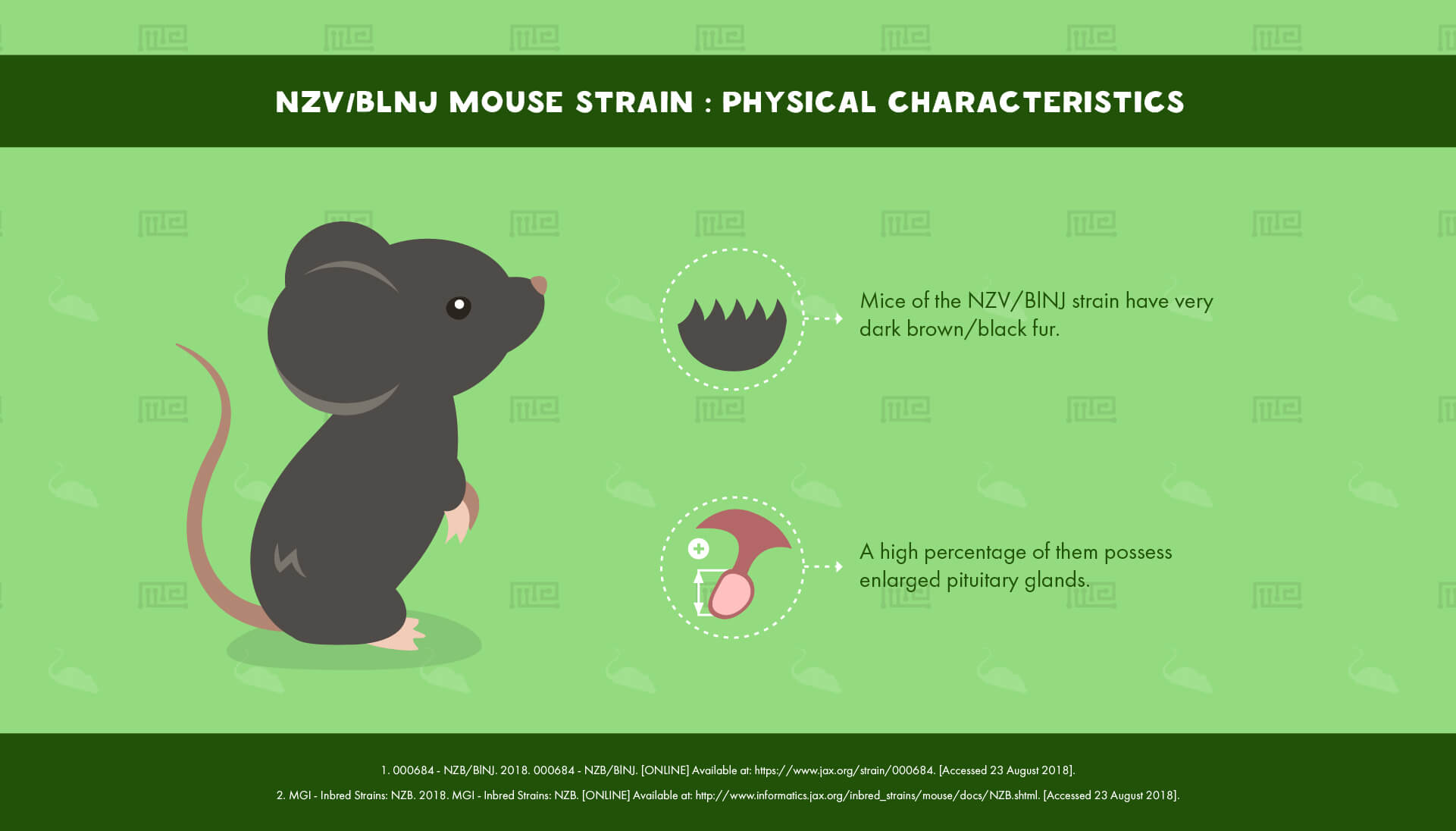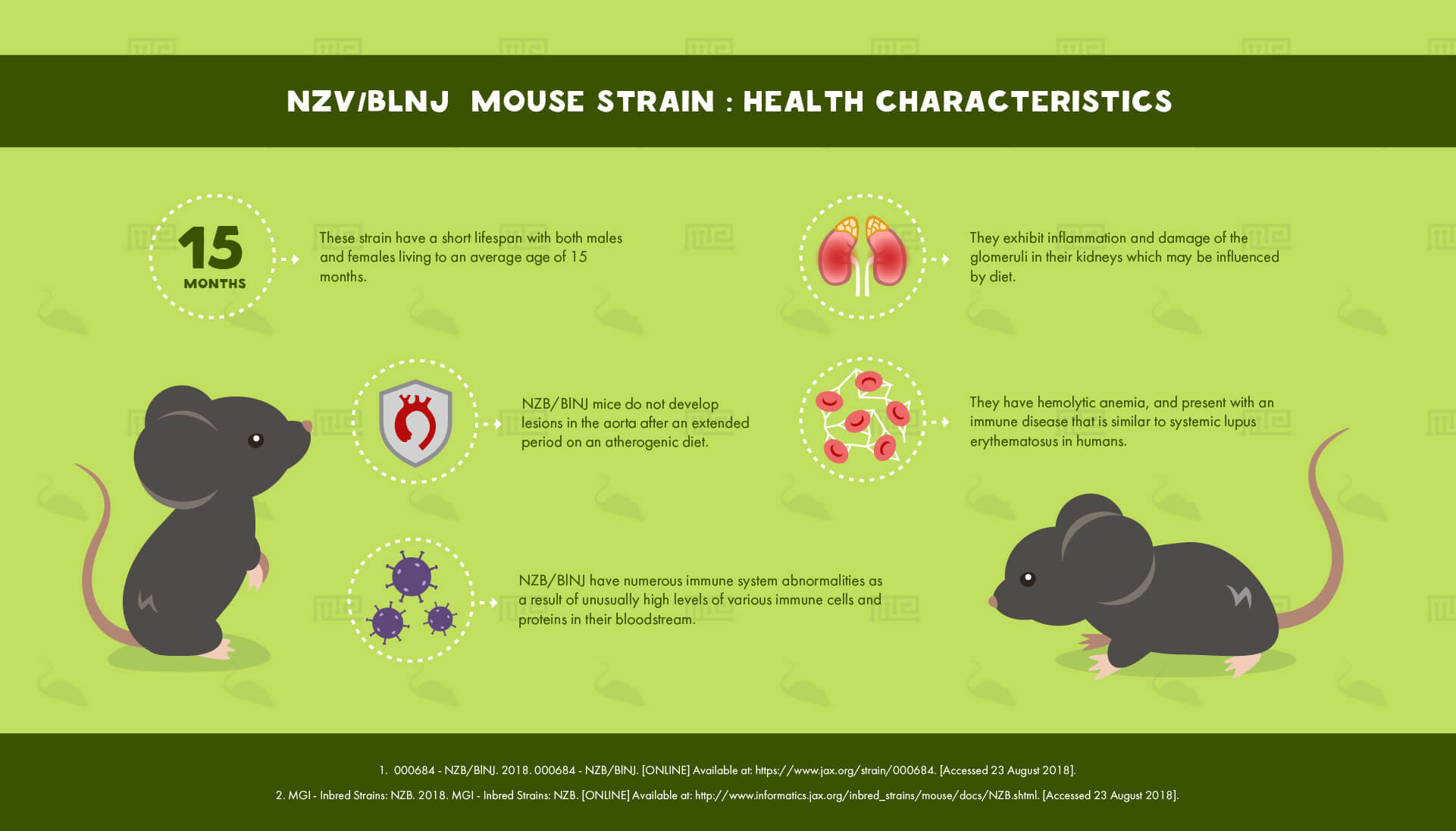Overview
NZB/BlNJ, where NZB stands for “New Zealand Black”, is an inbred strain of mouse model that is often used in research on human autoimmune disorders.
History
The NZB/BlNJ strain descends from mice that were outbred at the Imperial Cancer Research Fund in London, in the late 1920s. A stock of these mice was sent to the University of Otago Medical School in 1930.[1][2]
Inbreeding was started by Bielschowsky at the University of Otago in 1948, and a number of strains were derived from this inbred stock, including NZB. The NZB/BlN substrain came from the NIH to Russell at the Jackson Laboratory in the late 1960s.[1]
It should be noted that, according to the Jackson Laboratory, the fifth letter in this strain’s name is a lower case L (l), not an uppercase I or the number 1; these three characters may appear identical on a computer screen leading to orthographic errors.[1]
Behavioral Characteristics & Handling
A Canadian study[3] of the relative ease of handling of various commonly used mouse strains reports that NZB/BlNJ mice are extremely placid, receiving the highest placidity score of all 21 strains observed. They showed virtually no struggling or squeaking when held, or evasion when captured. Researchers can thus be extremely confident in dealing with these mice.
Autoimmunity presents with several behavioral abnormalities which are also observed in the NZB/BlNJ mice, such as elevated anxiety. This strain has been shown in one study to exhibit higher than normal anxiety in the elevated plus maze test.[4] Another study corroborates this evidence, as well as reporting low exploratory activity for these mice.[5]
Autoimmunity also confers complex learning and memory deficits. NZB/BlNJ mice perform badly in the shuttle box test of aversive learning,[6] as well as in the Lashley maze memory test.[7] By contrast, they perform quite well in the Morris water maze, despite displaying strange repetitive behaviors and seemingly unhelpful biases.[8]
Health Characteristics
Lifespan in this strain is short, with both males and females living to an average age of approximately 15 months.[2]
The most notable health characteristics of NZB/BlNJ are their numerous immune system abnormalities. They experience unusually high levels of various immune cells and proteins in their bloodstream, including immunoglobulins, immune complexes, anti-thymocyte antibodies, and anti-DNA antibodies.[1]
As a consequence of these abnormalities, the BZB/BlNJ mice exhibit inflammation and damage of the glomeruli in their kidneys.[1] The progression of this nephropathy can be unpredictable and may be influenced by diet.[2] They also have hemolytic anemia, and present with an immune disease that is similar to systemic lupus erythematosus in humans.[1]
Unlike susceptible strains such as C57BL/6J, NZB/BlNJ mice do not develop lesions in the aorta after an extended period on an atherogenic diet (high fat, high cholesterol).[1]
Major Experimental Uses
As a consequence of their immunological abnormalities, NZB/BlNJ mice are primarily used as a model for human autoimmune diseases, especially systemic lupus erythematosus.[1] Autoimmune disorders present with various psychological symptoms such as anxiety and learning deficits, for which these mice can also serve as a model (see above).
In addition to autoimmunity, they find applications in research on atherosclerosis, lymphatic deficits, anemia, and complement deficiency.[1]
References
- 000684 – NZB/BlNJ. 2018. 000684 – NZB/BlNJ. [ONLINE] Available at: https://www.jax.org/strain/000684. [Accessed 23 August 2018].
- MGI – Inbred Strains: NZB. 2018. MGI – Inbred Strains: NZB. [ONLINE] Available at: http://www.informatics.jax.org/inbred_strains/mouse/docs/NZB.shtml. [Accessed 23 August 2018].
- Wahlsten, D. Metten, P. Crabbe, JC. 2003. A rating scale for the wildness and ease of handling laboratory mice: results for 21 inbred strains tested in two laboratories. Genes, Brain and Behavior. 2; 71-79.
- Schrott, L. M., & Crnic, L. S. (1996). Increased anxiety behaviors in autoimmune mice. Behavioral Neuroscience, 110(3), 492-502.
- Schrott LM, Crnic LS. Anxiety behavior, exploratory behavior, and activity in NZB x NZW F1 hybrid mice: role of genotype and autoimmune disease progression. Brain Behav Immun. 1996 Sep;10(3):260-74.
- Schrott LM, Denenberg VH, Sherman GF, Waters NS, Rosen GD, Galaburda AM. Environmental enrichment, neocortical ectopias, and behavior in the autoimmune NZB mouse. Brain Res Dev Brain Res. 1992 May 22;67(1):85-93.
- Schrott LM, Denenberg VH, Sherman GF, Rosen GD, Galaburda AM. Lashley maze learning deficits in NZB mice. Physiol Behav. 1992 Dec;52(6):1085-9.
- Moy, S. S., Nadler, J. J., Young, N. B., Nonneman, R. J., Segall, S. K., Andrade, G. M., … Magnuson, T. R. (2008). Social Approach and Repetitive Behavior in Eleven Inbred Mouse Strains. Behavioural Brain Research, 191(1), 118–129.


